Lululemon Athletica (NASDAQ:LULU) has recently retreated from all-time highs, and the shares are near 2020 highs set about a year ago. The company reports FQ2 earnings after the market closes on Sept. 8. LULU closed at $391.16 on Sept. 1, 2020, after which the shares started a decline. The company reported FQ2 2020 results on Sept. 8, beating expectations on EPS and revenue, but the shares continued to fall, closing below $300 on Sept. 18. The shares spent much of the past year below $350, but rallied to close at a YTD high of $414.52 on Aug. 30. That run in share prices was triggered by strong FQ4 results (reported on Mar. 30).The shares are currently trading at around $390.
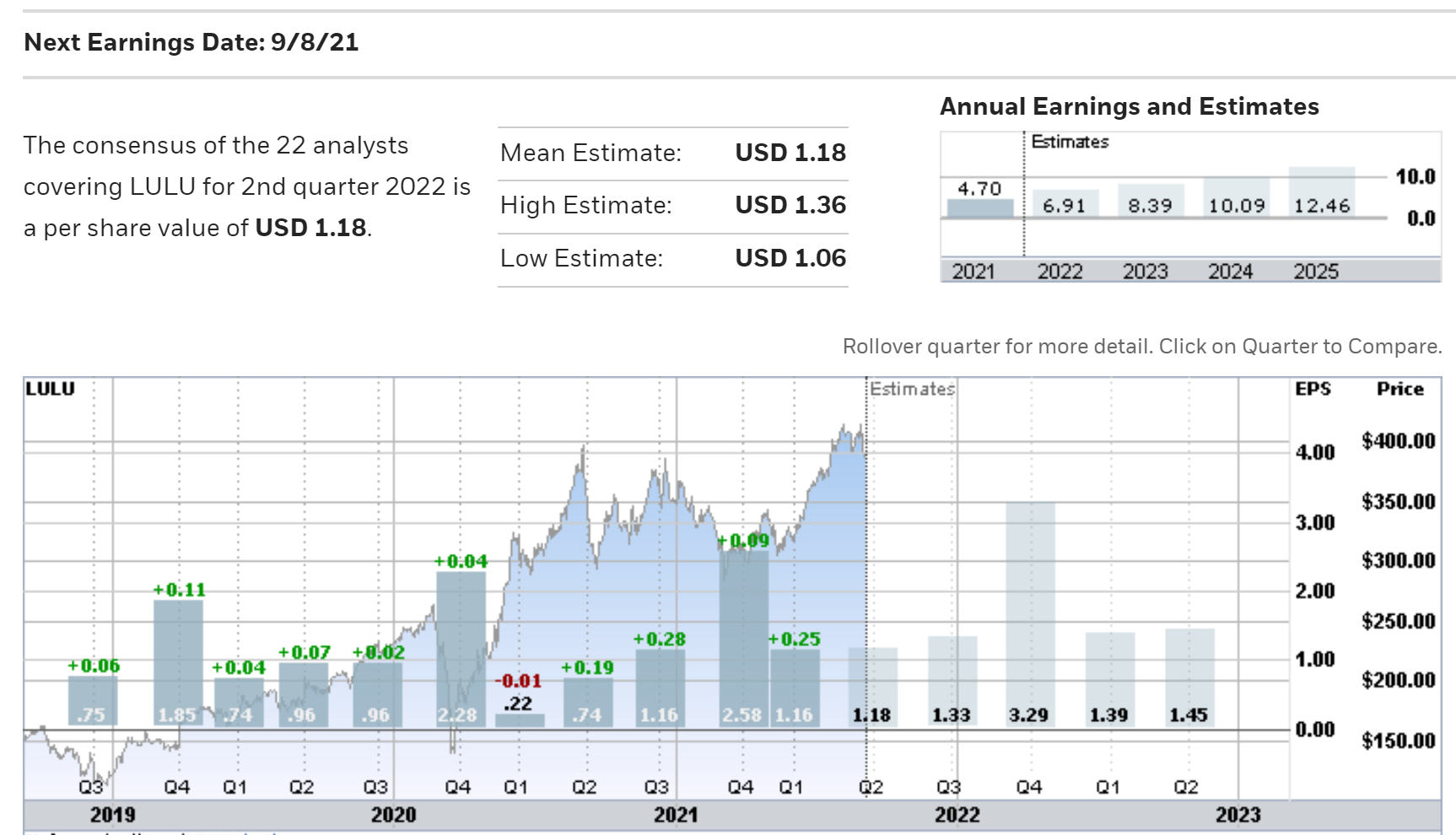
Source: eTrade. Green (red) values indicate amount by which EPS exceeded (missed) expectations.
Looking at trailing returns for various time horizons tells an interesting story. For the 12-month period through Sept. 3, the shares have gained 2.77%, as compared to 35.4% for the retail apparel industry and 35.1% for the US equity market as a whole. Over the trailing 3- and 5-year periods, however, LULU has annualized return that is far higher than either the retail apparel industry or the market as a whole.
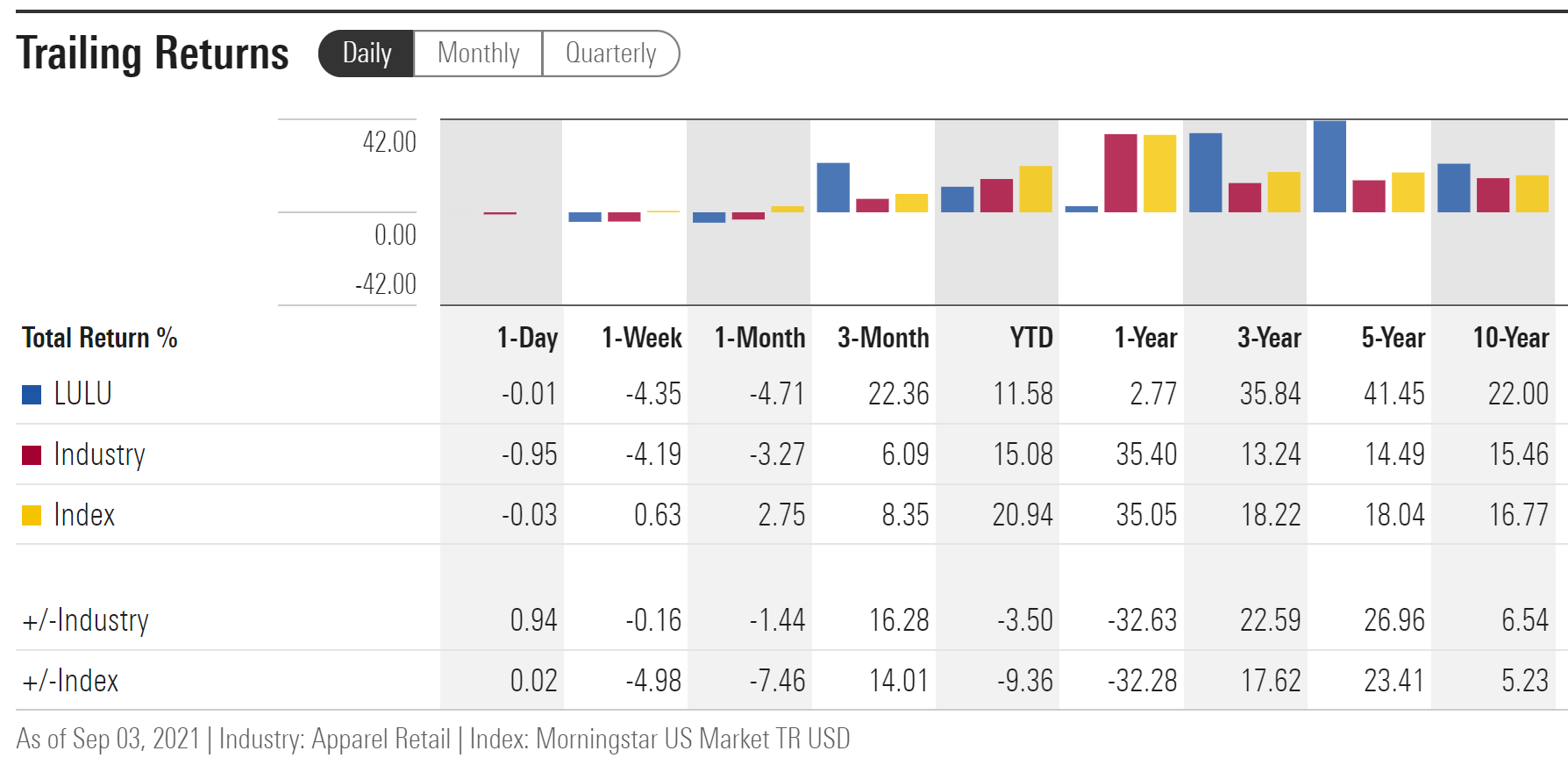
Source: Morningstar.com. Trailing returns for LULU vs. the Retail Apparel industry and the U.S. stock market as a whole.
LULU has a forward P/E of 57.1, far higher than Under Armour (NYSE:UA), which has a forward P/E of 36.2, and Nike (NYSE:NKE), with a forward P/E of 38.5. The question is whether the market thinks LULU’s share price has gotten too far ahead of earnings expectations for the near term or whether there is a broader revaluation going on. The valuation for a stock at this high a P/E is sensitive to variations in the expectations for earnings growth.
To formulate an opinion on LULU, I rely on two forms of consensus outlooks. The first is the Wall Street analyst consensus. When there is reasonable agreement between the analysts, the consensus price target has predictive value. The second form of consensus is the market-implied outlook, a probabilistic outlook for price returns derived by analyzing the prices of call and put options on the stock. The price of an option represents traders’ consensus estimate for the probability that the price of LULU will move above (call option) or fall below (put option) a specific level (the strike price) between now and when the option expires. By analyzing call and put option prices at a range of strikes and a common expiration, it is possible to infer the probabilities for future returns than reconcile the options prices. For readers who are unfamiliar with this concept, I have written an overview post, including links to the relevant financial literature.
Wall Street Consensus Outlook for LULU
eTrade’s calculation of the Wall Street consensus combines the views of 9 ranked analysts who have issued opinions within the past 90 days. The consensus rating for LULU is bullish and the consensus 12-month price target is 13.56% above the current price. Even the lowest of the price targets is 4.3% above the current price.
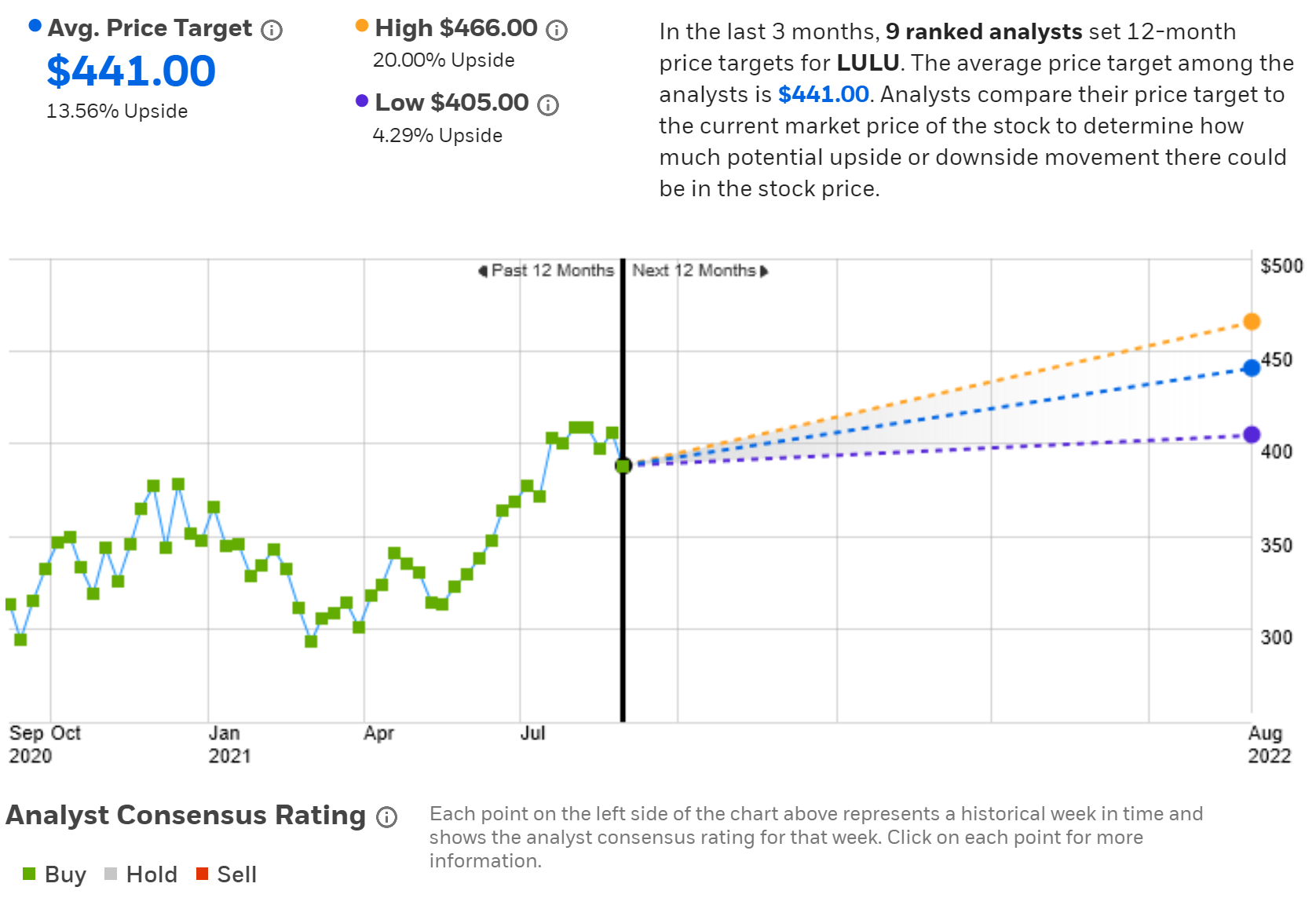
Source: eTrade
Investing.com’s version of the Wall Street consensus is calculated using 32 analysts. While the consensus rating is bullish, the consensus price target implies a 12-month return of only 3.92%. The average price target is dragged down by a $275 price target from BMO Capital analyst Simeon Siegal, which is not included in eTrade’s group of ranked analysts.
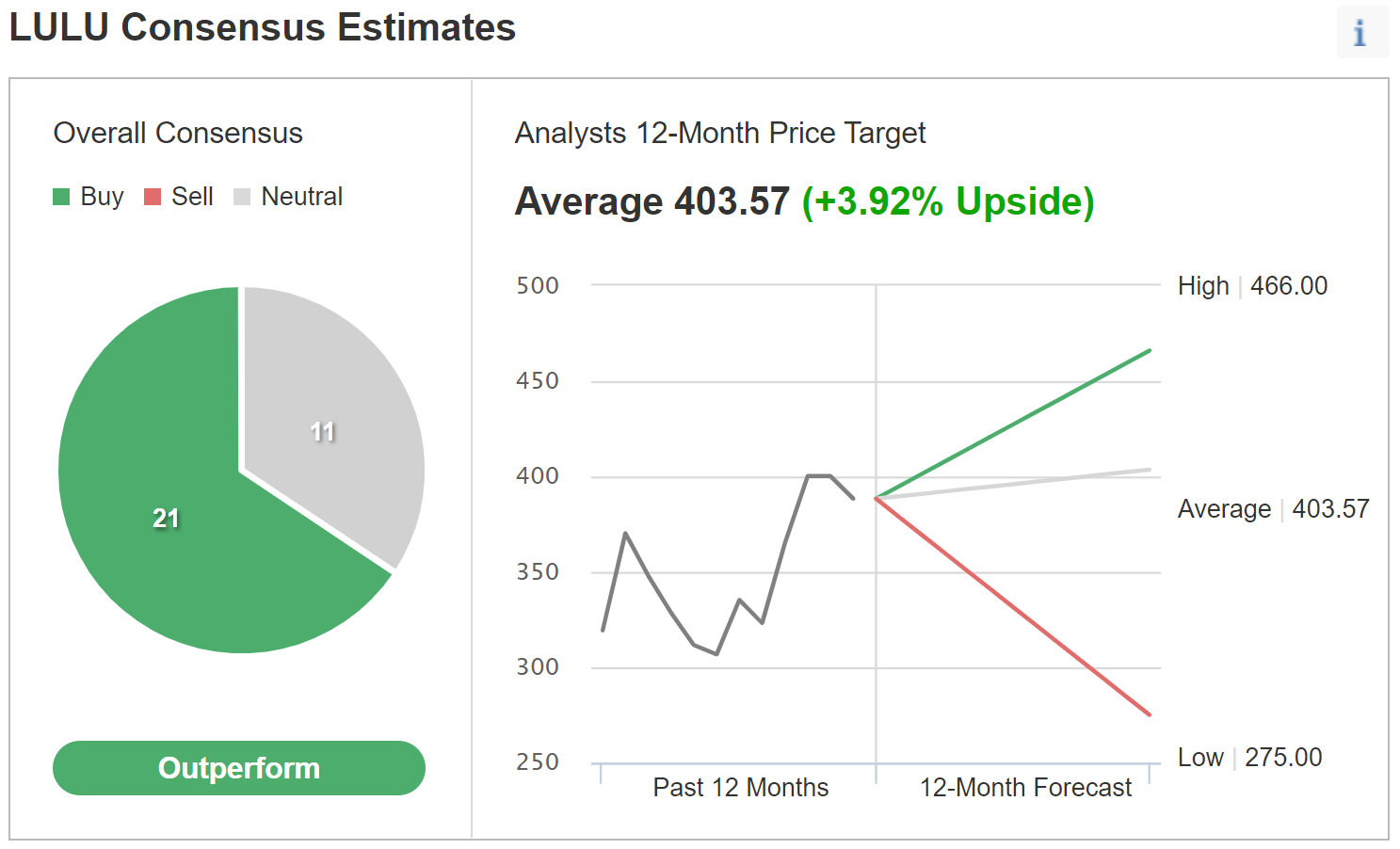
Source: Investing.com
This situation motivates looking at more than one calculation of the Wall Street analyst consensus. The consensus of ranked analysts from eTrade (rankings provided by Tipranks) has a markedly more optimistic price target than the consensus using a broader group of analysts. Both consensus outlooks are bullish, however.
Market-Implied Outlook for LULU
I have calculated the market-implied outlook for a 4.5-month time horizon (using options expiring on Jan. 21, 2022) and a 6.3-month time horizon (using options expiring on Marc. 18, 2022). I selected these two period to provide a view through the end of this year and into early 2022. The options trading volume on LULU is not terribly high, especially for the March 2022 options, so looking at two different time horizons provides more confidence in the consistency of the market-implied outlook.
The standard presentation of the market-implied outlook is in the form of a probability distribution of price return, with probability on the vertical axis and price return on the horizontal axis.
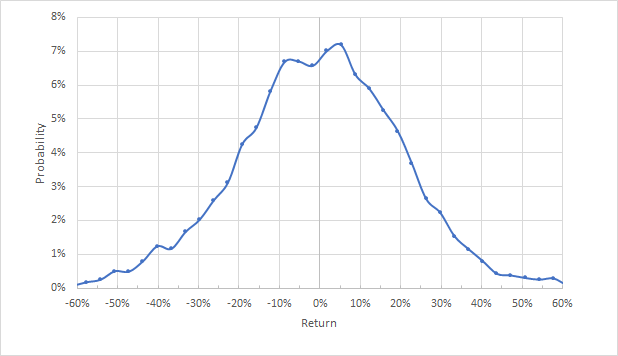
Source: Author’s calculations using options quotes from eTrade for the 4.5-month period from now until Jan.21, 2022.
The market-implied outlook for the next 4.5 months is generally symmetric, with comparable probabilities of positive and negative returns of the same size. The peak probability corresponds to a price return of +5%. The annualized volatility derived from this distribution is 35.3%.
To make it easier to directly compare the probabilities of positive and negative returns, I look at a version of probability distribution of returns with the negative returns rotated about the vertical axis (see chart below).

Source: Author’s calculations using options quotes from eTrade for the 4.5-month period from now until Jan. 21, 2022. The negative return side of the distribution has been rotated about the vertical axis.
While the peak probability is not well-defined, the probabilities of positive returns are consistently slightly higher than for negative returns of the same magnitude (the blue line is above the dashed red line for a wide range of the most probable returns). Theoretically, market-implied outlooks are expected to have a negative bias due to risk-averse investors buying put options. The positive tilt in this market-implied outlook is a bullish indicator.
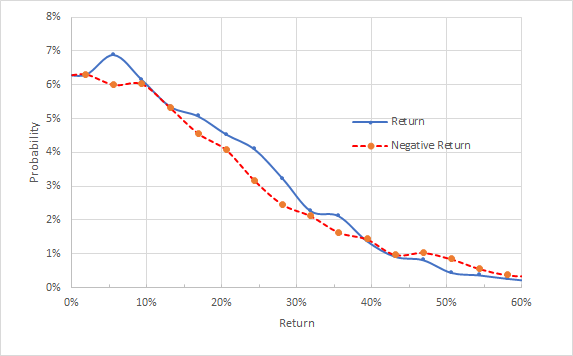
Source: Author’s calculations using options quotes from eTrade for the 6.3-month period from now until Mar. 18, 2022. The negative return side of the distribution has been rotated about the vertical axis.
The 6.3-month outlook to the middle of March is bullish, consistent with the results for the 4.5-month period. The probabilities of positive returns are consistently elevated relative to those for negative returns of the same magnitude. The peak probability corresponds to a price return of +5.6% and the annualized volatility is 35.6%. The options trading for this time horizon is thin, but the consistency with the shorter-term outlook adds confidence.
Summary
LULU has delivered high growth and impressive returns to investors over the past decade and particularly for the recent 3- and 5-year periods. The current valuation reflects the expectation that the company will be able to a high earnings growth rate. In this situation, a stock can experience rapid drops if investors get spooked, as LULU’s price history for the past 12 months demsontrates. The Wall Street consensus outlook for LULU is bullish, with expected 12-month price appreciation of ranging from 3.9% to 13.6%, depending on which consensus calculation you look at. The market-implied outlook to early 2022 is bullish, with expected (annualized) volatility of about 35%. I am inclined to discount the lower consensus price target due to the impact of the $275 outlier, in light of the positive views from the market-implied outlook and the otherwise consistently bullish views. My final overall rating is bullish.
